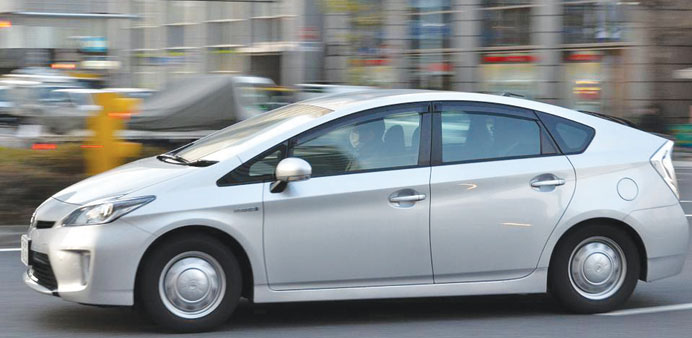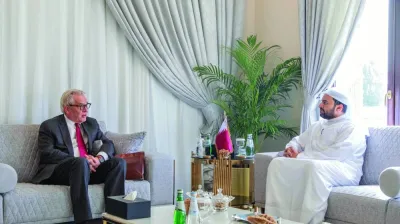Japanese auto giant Toyota Motor’s hybrid vehicle Prius is driven on a street in Tokyo. The Japanese firm yesterday unveiled a revamped manufacturing process built on sharing components among vehicles.
Dow Jones/Tokyo
Toyota Motor broke a two-year silence on a revamped manufacturing process – built on sharing components among vehicles – that the world’s best-selling auto maker says will produce half its vehicles by 2020 and slash costs.
But its unveiling follows a path blazed in recent years by German rival Volkswagen AG – a reversal for the Japanese pioneer, whose production system was for decades seen as the gold standard, giving the world such manufacturing concepts as “just-in-time inventory” and “continuous improvement.”
Toyota said the first vehicle to be launched under the new programme, known as Toyota New Global Architecture, will be built on a platform for midsize cars such as the Prius. Executive Vice President Mitsuhisa Kato said Toyota’s luxury-brand Lexus vehicles will also be made under the system.
“This has been a period to rebuild Toyota’s development and manufacturing procedures,” Kato told a briefing at Toyota’s headquarters in central Japan. “The entire company is working on a structural reform so that we can grow in a more sustainable way.”
Toyota didn’t specify how much savings the cost cuts are expected to deliver.
A decade ago, Toyota was confident about its rapid growth, backed by its ability to offer affordable and reliable vehicles and its manufacturing prowess. But that confidence was shattered by a series of crises the auto maker faced in the late 2000s. When the global financial crisis struck in late 2008 and auto sales plunged world-wide, Toyota struggled with high fixed costs stemming from excess production capacity as a result of its rapid expansion. That year Toyota posted its first annual operating loss in 70 years.
A year later, Toyota found itself embroiled in a spate of safety recalls after complaints over unintended acceleration in its vehicles.
These crises prompted Toyota to revamp its vehicle-development strategy under a motto set by President Akio Toyoda: make “ever-better cars.” Toyoda also froze investments in new plants for three years from 2013, saying Toyota needed to improve productivity before expanding again.
As Toyota developed its new manufacturing process, it found itself chasing Volkswagen, the world’s second-best-selling auto maker, which had launched in 2012 vehicles built on its own new global manufacturing platform. That system, known as MQB, was already utilising sharing of components across multiple brands and vehicles.
Hirohide Nakagawa, a Toyota engineer involved in platform development, said yesterday that in 2012, when Volkswagen started to sell its first vehicles built under MQB, Toyota engineers benchmarked and studied them carefully, at times adjusting its own development targets.
“We are coming into the game later than them, so our products have to be better than theirs,” he said. For instance, Toyota aims to improve the ride quality of its vehicles under the new programme, and it set a more aggressive target for noise and vibration reduction after studying Volkswagen vehicles, he said. Toyota said its new programme will reduce costs in several ways. The introduction of smaller manufacturing lines, for instance, is expected to reduce initial plant investment by approximately 40% compared with 2008 levels, Toyota said.
Toyota said it plans to increase the use of same or similar components across vehicles, regardless of size and segments, allowing it to order parts in bulk and save costs through economies of scale. The auto maker said it is also opening more business to suppliers outside the Toyota group, including European companies. For instance, German supplier Continental has recently started to supply Toyota with a new crash-prevention system, alongside with Toyota group supplier Denso, Toyota said.
Toyoda said in January that Toyota would likely end its self-imposed three-year freeze on investment in new plants soon. Toyota executives and people familiar with the matter have said the auto maker is considering investing in Mexico and China.



